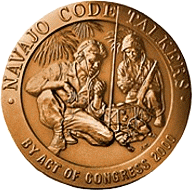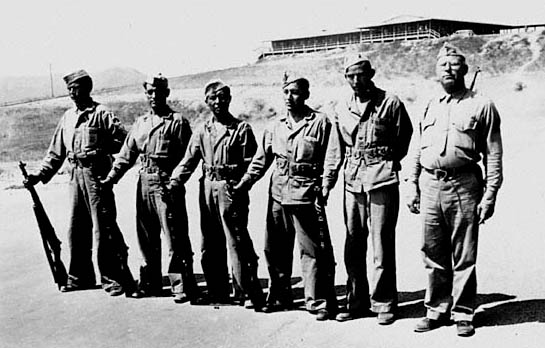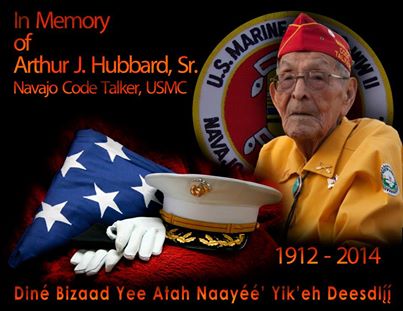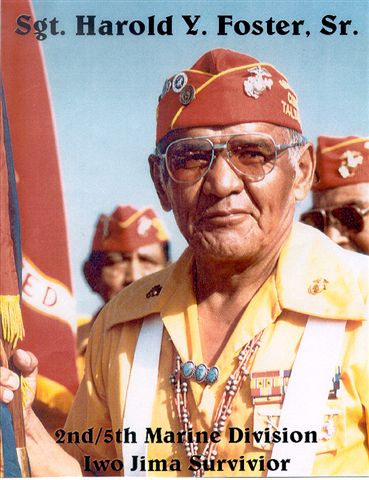Navajo Code Talkers
They Talked Navajo
“dine’ bi-zaad choz’-idd”

|
Navajo Code Talkers
|
|
Four of the five living Code Talkers, John Brown, Jr., Allen Dale June, Chester Nez and Lloyd Oliver, were able to travel to Washington DC to receive their gold medals. Teddy Draper, Sr. received his medal in New Mexico. Those Code Talkers who are no longer living, were represented by family members. In November 2002 more than 200 of the subsequent Code
Talkers received the Congressional Silver Medal at Window Rock, Arizona.
|
|
John Brown, Jr.
President Bush presenting the Congressional Medal of
Honor to John Brown |
The United States Marine Corps
Navajo Code Talkers
World War IIThe Navajo Nation, when called upon to serve the United States, contributed a precious commodity never before used. In the midst of the fighting in the South Pacific, a gallant group of young men from the Navajo Reservation utilized our language in coded form to help speed the allied victory.
Equipped with the only fool proof, unbreakable code in the history of warfare, the Navajo Code Talkers confused the enemy with an earful of sounds never before heard by code experts. The dedication and devotion to duty shown by the men of the Navajo Nation in serving as radio code talkers in the United States Marine Corps during World War II is an example for all Americans, the Navajo Nation and graduates of WRHS.
It is fitting that at this time we also express appreciation for the Navajo Code Talkers who lived among the communities of Fort Defiance, Old Sawmill, St. Michaels and the Window Rock areas, and the families who served the population with their children being former students and alumni of Window Rock High School
Camp Elliott, California Left—Right: Cpt. Johnny Manuelito (Naschitti, NM); John Benally (Fort Defiance, AZ), Pvt. Rex Kontz (Fort Defiance, AZ), Howard Billiman (Sawmill, AZ), Peter Tracey (Ganado, AZ) Design the NTC Project: Tech Sgt. Phillip Johnson (Leupp, AZ) |
 |
 |
Marine Code Talker Signal Unit
Front Row: Privates Earl Johnny, Kee Etsicitty, John V. Goodluck and Private First Class David Jordan.
Back row: Privates Jack C. Morgan, George H. Kirk, Tom H. Jones and Corporal Henry Bahe, Jr
Earl Johnny
Above two pictures Courtesy US Senate Jeff Bingaman, New Mexico
Navajo Code Talkers at WWII Memorial July 4, 1976
Front Row: Col. Walker, Arcencio Smiley, James Nahkai, Albert Smith, Harold Y. Foster, George Kirk; King, Mike; Wm. Dean Wilson.
2nd Row: Richard Thomas, Francis Thompson, Frank Thompson; John Goodluck, Teddy Draper, Eugene Crawford, Paul Blatchford, Jack Morgan.
3rd Row: Harold Beard, Keith Little, Frank Chee Willetto, Sidney Bedonie, Carl Gorman, Joe Kellwood, Bill Cadman, M. Link
NTCA at Window Rock Veterans Park Sept. 12, 2004
Front Row: John Brown, Peter MacDonald, Sidney Bedonie, Bill Toledo, Samuel Sandoval, Frank Thompson, Jimmy Begay, Joe Price, Edward Anderson, John Kinsel.
2nd Row: Arthur Hubbard, Harold Beard, Keith Little, Sam Billison, Wilford Buck, George Smith, Larry P. Foster (Son-of-Code Talker), Samuel Tso, Willard Oliver, Jean Whitehorse
Platoon 382. This was the first group of Navajos recruited as the pilot for the famous Navajo Code Talker program during World War II. They developed the original code of about two hundred terms. The Navajo code was later expanded to nearly... seven hundred by 1945, and approximately four hundred Navajos served as Code Talkers in the Pacific.
Front row: (left to right) Frank Denny Pete, Cpl. L.P. Kohl (Drill Instr.) Sgt. L.J. Stephenson (Drill Instr.), Cpl. R.J. Hayes (Drill Instr.), Wilsie Bitsie
Second row: (left to right) Chester Nez, Eugene R. Crawford, John Brown, Jr., Cosy (Cozy) S. Brown, John A Benally, Bill D. Yazzie (later changed name to William Dean Wilson), Benjamin H. Cleveland, Nelson S. Thompson
Third row: (left to right) Lloyd Oliver, Charlie Y. Begay, William McCabe, Oscar B. Ilthma, David Curley, Lowell S. Damon, Balmer Slowtalker (later changed his name to Joe Palmer), Alfred Leonard, Allen Dale June
Fourth row: James Dixon, Roy L Begay, Johnny R. Manuelito, Harry Tsosie, George H. Dennison, Carl N. Gorman, Samuel h. Begay, John Chee, Jack Nez, John Willie, Jr.
The last member of this group, Chester Nez, passed away at 93 on June 4, 2014.
Chester Nez
Local Code Talkers
Related To
Window Rock High School Alumni & Former Students
Benally Ashi , John
Benally, Johnson
Everett Ashi Benally, Class of 1959
Ronald Benally, Class of 1966
Janet Benally, Class of 1968Steven, Class of 1972
Geraldine, Class of 1977Benton, Willie
Billiman, Howard
Willie, Jr., Class of 1969 Francis, Class of 1973
Genice, Class of 1976Brown, Jr., John
Cadman, William “Bill”
Valery Showalter-Brandow, Class of 1990
Original Code Talker Decorated American and Navajo Hero Husband, Father, Grandfather & Great Grandfather. DetailsEdward, Class of 1966
Evangeline, Class of 1967
Earl, Class of 1969
Elouise, Class of 1971Cayedito, Del
Clauschee, Guy
Irving “Obit”, Class of 1964 Calvin, Class of 1966
Pat, Class of 1975
David, Class of 1978
Gilbert, Class of 1979Damon, Anson C.
Draper Sr., Teddy
Albert, Class of 1959
Alberta, Class of 1960
Roberta, Class of 1963
Anson Jr., Class of 1966
Loretta, Class of 1968
Elvira, Class of 1970Theodora Draper-Baldwin, Class of 1984 Mr. Draper Received a Purple Heart
59 years after WWIIFoster, Sr., Harold Y.
Francisco, Jimmy
Len , Class of 1967
Larry P., Class of 1968
Harold Chuck Jr., Class of 1971
Eugene Oree, Class of 1972Elmer, Class of 1965
Frank, Class of 1967
Jimmy, Jr., Class of 1968
Gene, Class of 1970
Marvin, Class of 1972Harding, Ben W.
Hardy, Tom
Benjamin, Class of 1968 Ron, Class of 1959
Freddie, Class of 1965
Tommy, Class of 1970Hawthorne, Roy
Hickman, Dean
Gerald, Class of 1969
Regan, Class of 1972
Gene, Class of 1974Dorothy, Class of 1960
Deanna, Class of 1962Johnny, Earl
Johnson, Deswood
Regina, Class of 1972
Diana, Class of 1976
Vincent Johnny, Class of 1980
Children of Diana:Bryan Johnny, Class of 1992Johana DeChilly, Class of 1999Jenna DeChilly, Class of 2003
Jania DeChilly, Class of 2016
Jaelyn DeChilly, Class of 2020
Children of Regina
Micah Francisco - Class of 1993
Shaunaci Francisco
Delmer Francisco
Chato Franc
Great-Grandchildren
Cooper Ryne Johnny
Noelani Francisco
Derek Francisco
Shaunice Calamity
Jason Calamity
Eric Calamity
Trenton Francisco
Carnell Manson
Talus Manson.Deswood Jr., Class of 1973
Daniel, Class of 1974Jose, Teddy
Keedah, Wilson
William, Class of 1959 Wilson, Jr., Class of 1960
Nelson, Class of 1963
Wilbert, Class of 1968
Margaret, Class of 1970Kontz, Rex
Little, Keith
Thomas, Class of 1967
Richard, Class of 1970
Debra, Class of 1971
Rexann, Class of 1972
Roxann, Class of 1973
Cynthia, Class of 1974
Geneva, Class of 1975
Rex, Jr., Class of 1978
Warren (Sandy), Class of 1981Kenneth, Class of 1966 MacDonald, Sr., Peter
Manuelito, Sr., James
Linda, Class of 1970
Rocky, Class of 1972James “Chooks”, Class of 1961
Michael, Class of 1964
Vernon , Class of 1968Miles, General
Nagurski, Adolph N.
James, Class of 1961
Joseph, Class of 1964
Doris, Class of 1965
Earl, Class of 1967
Beverly, Class of 1969Evelyn, Class of 1967
Mayfa, Class of 1968Nakaidine, Peter
Price, Joe
Phyllis, Class of 1975
Pat, Class of 1976Annie, Class of 1959
Fannie, Class of 1959
Manuel, Class of 1962
Herman, Class of 1964
Kathleen, Class of 1968
Melvin, Class of 1971
Evangeline, Class of 1973Slinkey, Richard
Smith, Sr., Samuel J.
Richard, Class of 1966
Rita, Class of 1966
Linda, Class of 1967
Ronald, Class of 1968
Michael ,Class of 1970Janice, Class of 1966 Sorrell, Sr., Benjamin G.
Tabaha, Sr., Johnnie
Tina Sorrell-Bowen, Class of 1987
Sandra Sorrell, Class of 1993
Robin Sorrell, Class of 1997Johnnie, Jr., Class of 1959
Beverly, Class of 1960
Alvina, Class of 1966
Diana, Class of 1967
Mary Louise, Class of 1968Thompson, Sr., Clare M.
Thompson, Frank T.
Robin , Class of 1970 Janice, Class of 1972
Francine, Class of 1982
Cassandra, Class of 1975
Frankie, Class of 1978
Terry, Class of 1980
Valerie, Class of 1986
Floyd, Class of 1976Upshaw, John
Williams, Kenneth
Benjamin, Class of 1968 Kenneth, Jr., Class of 1966 Yazza, Peter
Yazza, Vincent
Mae Francis, Class of 1964
Linda, Class of 1965
Daniel, Class of 1968
Arthur, Class of 1969
Yoland, Class of 1972Alex, Class of 1959 Zah, Henry
Lorraine, Class of 1966
After the war, these Navajo Codemen returned to their communities and through the years many held prominent positions with the Navajo Nation, Window Rock Public School District, Fort Defiance IHS Hospital, Fort Defiance local stores and trading posts.
The communities of Window Rock, Fort Defiance, Old Sawmill and St. Michaels, Arizona contributed the largest number of Navajo Code Talkers. Additionally, Window Rock High School is the alma mater of more Code Talker children than any other school in the United States.
On July 9-10, 1971, the Navajo Code Talkers held their first reunion. They elected their first officers and formed the Navajo Code Talkers Association at the Window Rock Fairgrounds. Today, the Navajo Code Talkers Association hold their monthly meetings at the Gallup Chamber of Commerce.
Larry Foster
Proud Son of a Code Talker
Window Rock High School
Class of 1968
Complete List of Code Talkers
(Click Picture)
(Click for Reference Material )
The symbol of the Code Talker represents a communication device used by two young Navajo boys called the Hero Twins. The device allowed them to secretly communicate with each other.
When monsters were plaguing the Dine' (Navajo People), the legendary Hero Twins were sent to the Sun to seek a weapon that would kill all the monsters. The Sun gave them the Thunderbolt as a weapon to use.
All of these elements are represented in the unique and interesting Code Talker Emblem and is also pictured on the reverse side of the Congressional Medals.
Carl Gorman, creator and Code Talker, felt that this was a fitting symbol for this brave group of men who gave so much for their country.
Veterans Day 2009
The following was provided by Diana DeChilly, WRHS Class of 1976 and daughter of Code Talker Earl Johnny:
Navajo Code Talkers to be in NYC Veterans parade
By ULA ILNYTZKY
ASSOCIATED PRESS WRITERNEW YORK -- The famed Navajo Code Talkers, the elite Marine unit whose unbreakable code stymied the Japanese in World War II, fear their legacy will die with them.
Only about 50 of the 400 Code Talkers are believed to be still alive, most living in the Navajo Nation reservation that spans Arizona, New Mexico and Utah. Many are frail or ill, with little time left to tell the world about their wartime contribution.
But on Wednesday, 13 of the Code Talkers are coming to New York City to participate for the first time in the nation's largest Veterans Day parade.
The young Navajo Marines, using secret Navajo language-encrypted military terms, helped the U.S. prevail at Iwo Jima and other World War II Pacific battles, serving in every Marine assault in the South Pacific between 1942-1945. Military commanders said the code, transmitted verbally by radio, helped save countless American lives and bring a speedier end to the war in the Pacific theater.
They were sworn to secrecy about their code, so complex that even other Navajo Marines couldn't decipher it. Used to transmit secret tactical messages via radio or telephone, the code remained unbroken and classified for decades because of its potential postwar use.
"We were never told that our code was never decoded" or given identities of the original 29 Navajos who created it, said Keith Little, 85, who joined the Marines at 17 and remembers crouching in a bomb crater amid heavy fire on Iwo Jima.
"It was all covered by secrecy. We were constantly told not to talk about it," said Little. The Code Talkers felt compelled to honor their secrecy orders, even after the code was declassified in 1968.
Little plans to go to New York with the other Code Talkers, many of whom were young farmers and sheepherders and had never been away from home before the war.
"The code did a lot of damage to the enemy," said Samuel Tom Holiday, 85, of Kayenta, Ariz., who also is joining the parade. He was a 20-year-old Code Talker when he and two other Marines went behind enemy lines on Iwo Jima to locate a Japanese artillery unit advancing on American forces.
Once the unit was located, Holiday transmitted a coded message to Marine artillery, which fired a big shell at the Japanese. After the Marine rifleman proclaimed it "right on target," Holiday messaged "Right on Target" to a Navajo Code Talker in Marine artillery.
Though the Code Talkers transmitted information on tactics and troop movements, orders and other vital battlefield communications, they did not know at the time how those messages figured in the greater battle strategy.
Today "there's a certain elation about" knowing how much their work affected the outcome of the war, said Little, who runs a family ranch in Crystal, N.M., on the Navajo Nation.
Before the code, the Japanese intercepted and sabotaged U.S. military communications at an alarming rate because they had expert English translators. American forces then devised ever more complicated codes, but that increased the time - sometimes hours - for sending and decoding them.
The code, based on the ancient Navajo language, changed that. In the first 48 hours of the battle of Iwo Jima, six Code Talkers worked nonstop, transmitting and receiving more than 800 messages about troop movement and enemy fire - none deciphered by the Japanese. What confounded the enemy most was that Code Talkers could use distinctly different words for exactly the same message.
Recognition from the U.S. government and awareness of the Code Talkers - even within the Navajo community - has been slow to come. It wasn't until 2000 that the Congressional Gold Medal was bestowed on the survivors of the original 29 Code Talkers and silver medals on the rest.
At least five of the Code Talkers died just this year, creating an urgency for the Navajo Code Talkers Foundation to create a museum in their honor in New Mexico, near the Navajo capital of Window Rock, Ariz. It is slated to open sometime in 2012.
Yvonne Murphy, a foundation board member and daughter of Code Talker Raymond R. Smith Sr., who died seven years ago, did not hear of the Code Talkers until she was 16.
"I saw this outfit lying on the bed ... a Marine gold-colored shirt," she said, the uniform of the Code Talkers, laid out with some Navajo jewelry. But it wasn't until she was in her 30s, "that I was able to grasp the whole concept," added Murphy, 45.
The Code Talkers coming to New York this week hope to highlight their efforts and funding needs for the museum, slated to open sometime in 2012.
On Tuesday, they will visit ground zero and the World War II aircraft carrier the USS Intrepid, where they will give a proclamation on behalf of the Navajo Nation to Mayor Michael Bloomberg.
"A lot more Marines would be dead right now," if not for the Code Talkers, said parade chairman Patrick Gualtieri.
"Our language was used to help win the war," said Holiday.
"After we're all gone, there will be no one to tell the story."